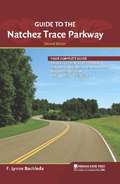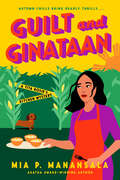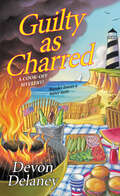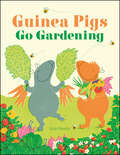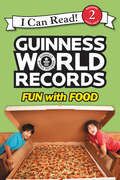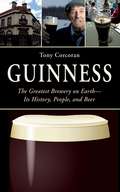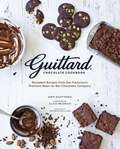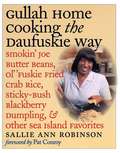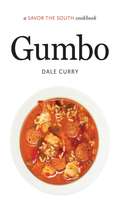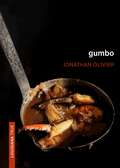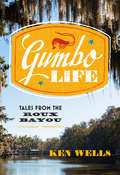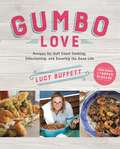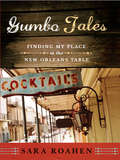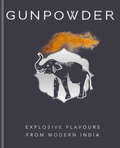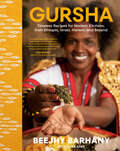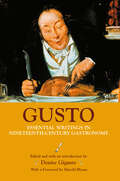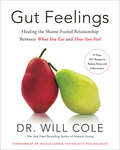- Table View
- List View
Guide to the Alaska Highway
by Ron DalbyTraveling across the great northern expanses from Dawson Creek, British Columbia, to Delta Junction, Alaska, the 1,500-mile Alaska Highway remains one of the greatest driving adventures of all time. Inside you will find details on gas prices, where to camp, how to prepare your vehicle for the journey, and insightful driving tips.Tips scattered through the guidetell you where to spot wildlife,let you in on a few favorite fishing holes, andhighlight important destinations.Brimming with full-color photography, Guide to the Alaska Highway is the most stunning, the most complete, and most thoroughly researched book on the market today. This invaluable guide will help travelers tailor a safe, pleasant, and enjoyable drive through some of the most scenic and rugged landscape on Earth. This guide is perfect for the adventure lover.
Guide to the Blue Ridge Parkway
by Nichole Blouin Frank Logue Victoria LogueFlowing among the beautiful mountains and valleys of Virginia and North Carolina, the 469-mile-long Blue Ridge Parkway is a true American jewel. Built to expose motorists to nature as well as to preserve its beauty, the Parkway still delivers unrivaled beauty today. Guide to the Blue Ridge Parkway is filled with information useful to those traveling the Parkway and is detailed with color photographs throughout. It highlights the many significant points of interest located on and nearby the Parkway, including Mount Mitchell, the highest point east of the Mississippi, Moses H. Cone Memorial Park, and Mabry Mill, one of the most photographed sites on the Parkway. Also noted are locations of overlooks, waterfalls, and tunnels as well as key entry and exit points along the Parkway. The guide features a brief history of the Parkway itself, a look at the surrounding geology and human history of the area, and an extensive wildflower bloom calendar. The book is organized mile-post to mile-post, appropriate for travelers who are driving the entire Blue Ridge Parkway or only a small section.
Guide to the Natchez Trace Parkway
by F. Lynne BachledaA unique journey through the heart of the Deep South, The Natchez Trace Parkway traverses 444 miles from Natchez, Mississippi, across the mighty Tennessee River in northwestern Alabama, to its northern terminus just shy of Nashville, Tennessee. For travelers planning a visit or already on the way, Guide to the Natchez Trace Parkway will help them discover all that the historic byway has to offer. From milepost to milepost, discover an ancient trail blazed hundreds of years ago by Native Americans that, in the early nineteenth century, became a trekking road for river boaters, who had sold their goods and vessels and were now headed back to central Tennessee and beyond.Visitors can drive the entire length, sampling the hundreds of scenic areas, restaurants, inns, exhibits, recreation areas, and other sites along the way. Motorcyclists will want to cruise the entire length as well, but will especially savor the hundreds of miles of meandering road between Natchez and Tupelo. For an even more intimate experience, Guide to the Natchez Trace Parkway shows where to hike on over 60 miles of National Scenic Trail, where to camp, and gives tips on bicycling the parkway's scenic length.Whether exploring a few miles or a few hundred miles, visitors will enjoy it most with the Guide to the Natchez Trace Parkway.
Guilt and Ginataan (A Tita Rosie's Kitchen Mystery #5)
by Mia P. ManansalaAutumn is in full swing for the town of Shady Palms—the perfect time for warm drinks, cozy cardigans, and…dead bodies? The annual Shady Palms Corn Festival is one of the town&’s biggest moneymakers, drawing crowds from all over the Midwest looking to partake in delicious treats, local crafts, and of course, the second largest corn maze in Illinois. Lila Macapagal and her Brew-ha Cafe crew, Adeena Awan and Elena Torres, are all too happy to participate in the event and even make a little wager on who can make it through the corn maze the fastest—but their fun is suddenly cut short when a dead body is found in the middle of the maze…and an unconscious Adeena lies next to it, clutching a bloody knife. The body is discovered to be a local politician&’s wife, and all signs—murder weapon included—point to Adeena as the culprit. But Lila knows her best friend couldn&’t have done this, so she and her crew put on their sleuthing caps yet again to find the killer who framed Adeena and show them what happens when they mess with a Brew-ha…
Guilt-Free Baking
by Gee CharmanLife's too short to feel guilty about eating cake... Low-fat and low-calorie baking doesn't have to mean filling your cakes with artificial sweeteners or bland low-fat substitutes. Instead, delight in guilt-free goodies that use innovative and healthy ways to add flavour and texture, so you won't feel that all the fun bits have disappeared! Gee Charman is from the new school of low-fat baking. Focusing on using healthy ingredients with fantastic flavours, as well as good fats that actually help you to lose weight, she gives you cakes and cookies, tarts and tray bakes, and fondants and frostings that you can eat to your heart's content. Rather than filling her bakes with artificial sweeteners or bland low-fat substitutes, she finds ingenious ways to add flavour and texture to low-fat cakes. Try Chocolate Cupcakes, for example, made with a delicious melted dark chocolate and avocado frosting (full of healthy flavanols and essential fatty acids), use tofu to create a soft, creamy Raspberry Ripple Cheesecake, or add rosemary to a low-fat Plum & Almond Tart to make it taste divine. Whether you want to whip up a simple treat for a rainy day, create a show-stopping spread for a party, or enjoy a romantic, indulgent dessert, this book will show you how you can have your cake and eat it!From the Hardcover edition.
Guilt-Free Nice Cream: Over 70 Amazing Dairy-Free Ice Creams
by Margie BroadheadMove over ice cream, hello nice cream! With over 70 fresh and vibrant recipes, Guilt-Free Nice Cream has everything you need to know about creating delicious and flavourful dairy-free nice cream. Using bananas as the base, you simply add your main ingredients of choice, churn, chill and hey presto, you have your very own healthy ice cream! Flavours include classics such as Strawberry and Rhubarb Crumble, Banana Rum n Raisin and Raspberry Ripple as well as more inventive combinations such as a tropical Pina Colada Nice Cream served inside a pineapple! Margie also shows you how you can use your nice cream as a show-stopping dessert including a triple layer Neopolitan Nice Cream Cake, Double-Choc Salted Caramal Mini Magnums and an exquisite Peanut Butter and Chocolate Tart. Not just for dessert, nice creams also make a healthy choice for breakfast; use in smoothie bowls, shakes, granola pots or for ultimate indulgence, serve on top of waffles or pancakes! Complete with recipes for fun sauces and toppings, cookies, brownies and a highly addictive Caramel Popcorn, Guilt-Free Nice Cream is the only frozen-treat you will need this summer: natural, nice and (just a little bit) bananas!
Guilt-Free Sweet Treats: Delicious 300-Calories-or-Less Desserts
by The Editors of Woman's DayAmericans are becoming more and more health conscious, and while they are paying more attention to what they eat, it does not mean that they are cutting out flavor and fun out of their diets. This collection of 80 of the best Woman's Day's dessert recipes with just 300 calories or less per serving, contains every type of treat for the nutrition minded cook, conveniently organized by type: Classic Cookies like double-chocolate oatmeal bars and chocolate-dipped macaroons; Sophisticated Cakes like orange cream mini-cheesecakes and chocolate s'mores cake; Elegant treats like strawberry cannoli and best biscotti; Beautiful Fruit Pies like blueberry tart and nectarine and plum galette; and Deliciously sinful Ice Cream treats like cherry ice cream cake and rum raisin pumpkin ice cream pie. Guilt-Free Sweet Treats is your reference for the baking and cooking tips to transform a dessert from sinful to secretly healthy. The recipes are all affordable, easy, and fun! Whether you know someone with a sweet tooth or you are the culprit, this cookbook is the best way to indulge yourself without any guilt!
Guilty as Charred (A Cook-Off Mystery #3)
by Devon DelaneySherry Oliveri has attained celebrity status after winning the America’s Good Taste Recipe Contest with her delectable New England Crab Cake Sliders. But now that she’s back home in Connecticut, she’s got to deal with something else fishy . . . Sherry’s making a guest appearance on a local radio show when the news comes in: Poppy Robinson has been found dead in the town’s community garden. Sherry was supposed to be taking questions about her win in the national cooking competition, but instead the callers start dishing dirt. Poppy and Sherry were both involved in the vegetable garden, and while Poppy may have been a bit priggish, it wasn’t anything that called for a shovel to the back of the head. There was already trouble brewing, with the owner of the land threatening to renege on their agreement, and this murder has taken tensions to a new level. Now while Sherry’s organizing a Fourth of July cook-off event, she’s also got a murder investigation on her plate . . . Includes Recipes from Sherry’s Kitchen!
Guinea Pigs Go Gardening (The Guinea Pigs)
by Kate SheehyIntroduce your little one to Bob and Ginger, two adorable guinea pigs who love the outdoors, fresh produce, and - most of all - gardening!Bob and Ginger will show little ones how to grow fruit and vegetables in this sweet children&’s book. It&’s perfect for encouraging children aged 3-5 years to spend more time in the garden.Visit Bob and Ginger in their beautiful garden filled with vibrant red strawberries, glossy green spinach, pretty purple aubergines, and more! From clearing the garden of weeds and planting seeds to learning how to make compost and finally harvesting their crops, kids will love following their green-fingered gardening adventures! A rainbow of fruit and vegetables come to life through vibrant, distinctive illustrations. The sweet, simple text and exciting storyline ensure that young readers stay engaged. Packed with lots of opportunities for meaningful parent-child interaction, this delightful gardening book is perfect for growing little gardeners! Go on a Glorious Gardening AdventureIt takes more than just seeds and water to create and care for your very own garden! Kids will discover the ups and downs of gardening with Bob and Ginger. From battling slimy slugs munching on their vegetables to pesky pigeons diving for their strawberries, this animal picture book teaches children about the natural world. This charming board book also features fun facts and tips about gardening, such as instructions on how to make compost, a calendar of seasonal fruits and vegetables, and how to protect strawberries from pigeons. It&’s the ultimate gift for kids who love gardening and to encourage a love of nature.
Guinness World Records: Fun with Food (I Can Read Level 2)
by Christy WebsterA brand-new Guinness World Records book for kids!We hope you’re hungry! Fun with Food has plenty of options to whet your appetite: the largest grilled cheese, the tallest cake, the most expensive hot dog, and more. Simple text and full-color photos will make learning about exciting topics fun for beginning readers.Guinness World Records: Fun with Food is a Level Two I Can Read book, geared for kids who read on their own but still need a little help.
Guinness: The Greatest Brewery on Earth—Its History, People, and Beer
by Tony CorcoranThere is no other company, industry, or premises more closely aligned--indeed almost synonymous--with its hometown than Guinness's St. James's Gate Brewery and the city of Dublin. From the company's modest beginnings in 1759 to its heyday in the late nineteenth and early twentieth centuries and its continued strength into the twenty-first century, Guinness has had an enormous influence over the city's economic, social, and cultural life.In this warm and fascinating piece of history, Tony Corcoran examines the magnitude of the brewery's operation, and the working lives of the thousands of Dubliners who have depended on Guinness for their livelihood, either directly or indirectly. The company's unusually progressive treatment of its workers--health care, training, and housing--is revealed in detail, as is the Guinness family's philanthropy and compassion towards the less well-off residents of the city. Tracing Guinness's progressive attitudes to their roots, Corcoran also explores the important roles of the strong-willed women in each generation of the Guinness dynasty. Guinness is a labor of love, full of anecdotes, humor, and historical insights into one of Dublin's most important and best-loved institutions."Whenever I bleed, I am always surprised to see that my blood is not black. Certainly, when you consider that I was born into two Guinness families, had two Guinness grandfathers and five Guinness uncles, and was on the premises of Guinness before I could walk, I am as much a product of Guinness as the black stuff itself." --Tony Corcoran
Guittard Chocolate Cookbook
by Antonis Achilleos Alice Medrich Amy GuittardChocophiles are discovering what professional bakers such as Alice Medrich and David Lebovitz have known all along: Guittard, San Francisco's oldest continuously family-owned chocolate company, makes some of the best premium chocolate available. With 50 tempting photographs and 60 simple recipes for every kind of indulgence, Amy Guittard presents tried-and-true favorite recipes from five generations of Guittards, ranging from start-your-day-right Chocolate Cherry Scones to fudgey Mocha Cookies and deep, dark Chocolate Caramel Pecan Bundt Cake. Leave it to the people who really know chocolate to make a collection of recipes that are sure to make every chocolate lover long for one bite more.
Gullah Home Cooking the Daufuskie Way
by Sallie Ann RobinsonIf there's one thing we learned coming up on Daufuskie," remembers Sallie Ann Robinson, "it's the importance of good, home-cooked food." In this enchanting book, Robinson presents the delicious, robust dishes of her native Sea Islands and offers readers a taste of the unique, West African-influenced Gullah culture still found there.Living on a South Carolina island accessible only by boat, Daufuskie folk have traditionally relied on the bounty of fresh ingredients found on the land and in the waters that surround them. The one hundred home-style dishes presented here include salads and side dishes, seafood, meat and game, rice, quick meals, breads, and desserts. Gregory Wrenn Smith's photographs evoke the sights and tastes of Daufuskie."Here are my family's recipes," writes Robinson, weaving warm memories of the people who made and loved these dishes and clear instructions for preparing them. She invites readers to share in the joys of Gullah home cooking the Daufuskie way, to make her family's recipes their own.
Gumbo
by Dale CurryRecalling childhood visits to her grandmother's house in New Orleans, where she would feast on shrimp and okra gumbo, Dale Curry offers fifty recipes--for gumbos, jambalayas, and those little something extras known as lagniappe--that will put Louisiana taste and hospitality on your table. "Gumbo" calls to mind the diverse culinary traditions of Louisiana that, like gumbo itself, are simmered from elements of the many cultures circulating in the state. Drawing historically from French, African, Caribbean, Native American, Spanish, Italian, and other culinary sources, the Creole and Cajun cooking featured in Gumbo embraces the best of local shellfish, sausages, poultry, and game. The heart of Louisiana home cooking--and now showcased by of chefs across the South and beyond--gumbo, jambalaya, and lagniappe traditionally drew from the state's waterways and estuaries rich with crustaceans, swamps exploding with waterfowl and alligators, and forests full of game. From the land came rice and peppers, two leading ingredients in gumbo and jambalaya. Recipes include classic and traditional dishes, as well as specialties offered by star chefs Bart Bell, Leah Chase, Emeril Lagasse, Donald Link, and Tory McPhail. With Curry's easy-to-follow instructions at hand, home cooks will be ready to let the good times roll at every meal.
Gumbo (Louisiana True)
by Jonathan OlivierGumbo adorns menus from New Orleans to New York to New Delhi, appearing in variations such as chicken and sausage gumbo, gombo z’herbes, and seafood gumbo. Some cooks use roux, others okra, and adding tomatoes to the pot can provide extra flavor or start a fight. Within this spirit of diversity lies the beauty of gumbo.Two culinary creations—West African okra stew and Choctaw soup—helped birth Louisiana gumbo. The Choctaw ground up sassafras, called filé, while West Africans like the Bambara provided okra and rice. From there, Spanish Caribbean influences introduced hot peppers and spices, the Germans pioneered smoked sausage and andouille, and the French devised the roux. Gumbo traces the history of how colonization, slavery, immigration, industry, and seasonality all had an impact on which ingredients wound up in the gumbo pot.
Gumbo Life: Tales From The Roux Bayou
by Ken WellsA sprightly, deeply personal narrative about how gumbo—for 250 years a Cajun and Creole secret—has become one of the world’s most beloved dishes. Ask any self-respecting Louisianan who makes the best gumbo and the answer is universal: “Momma.” The product of a melting pot of culinary influences, gumbo, in fact, reflects the diversity of the people who cooked it up: French aristocrats, West Africans in bondage, Cajun refugees, German settlers, Native Americans—all had a hand in the pot. What is it about gumbo that continues to delight and nourish so many? And what explains its spread around the world? A seasoned journalist, Ken Wells sleuths out the answers. His obsession goes back to his childhood in the Cajun bastion of Bayou Black, where his French-speaking mother’s gumbo often began with a chicken chased down in the yard. Back then, gumbo was a humble soup little known beyond the boundaries of Louisiana. So when a homesick young Ken, at college in Missouri, realized there wasn’t a restaurant that could satisfy his gumbo cravings, he called his momma for the recipe. That phone-taught gumbo was a disaster. The second, cooked at his mother’s side, fueled a lifelong quest to explore gumbo’s roots and mysteries. In Gumbo Life: Tales from the Roux Bayou, Wells does just that. He spends time with octogenarian chefs who turn the lowly coot into gourmet gumbo; joins a team at a highly competitive gumbo contest; visits a factory that churns out gumbo by the ton; observes the gumbo-making rituals of an iconic New Orleans restaurant where high-end Creole cooking and Cajun cuisine first merged. Gumbo Life, rendered in Wells’ affable prose, makes clear that gumbo is more than simply a delicious dish: it’s an attitude, a way of seeing the world. For all who read its pages, this is a tasty culinary memoir—to be enjoyed and shared like a simmering pot of gumbo.
Gumbo Love: Recipes for Gulf Coast Cooking, Entertaining, and Savoring the Good Life
by Thomas Mcguane Lucy BuffettA delicious love letter to the Gulf Coast's vibrant food culture.Since she was a young girl, Lucy Buffett has believed in the power of gumbo-the stirring, the transformation of the roux, the simple ingredients cooking up into something much better than just the sum of its parts. It's only fitting that she signs her name with "Gumbo Love" and that she makes a living feeding people the most delicious, soul-satisfying food. Her new cookbook, GUMBO LOVE, is a labor of love and includes recipes from all over the Gulf Coast. The dishes incorporate Caribbean, Cajun, Cuban, Mexican, Old Florida, and Creole influences. Lucy proves through her collection of recipes that the Gulf Coast has its own distinct flavors and traditions that make it a coastal destination year after year. And with some of the best seafood and produce the country has to offer, the Gulf Coast-beyond just New Orleans-has a vibrant cuisine and culture, making it a treasured culinary destination in its own right.Lucy combines over one hundred new recipes with old favorites. She lives by her mother's philosophy: "Life is short-eat dessert first," so the very first chapter is filled with delectable sweets like Classic Southern Pound Cake with Strawberries, Buttermilk Orange Chess Pie, and Salted Butterscotch Blondies. Since you can't live on dessert alone, you'll find Gulf Coast favorites from Tailgate Shrimp and Crab Dip to Lucy's Signature Summer Seafood Gumbo, and Crab and Corn Fritters, along with dozens of other seafood appetizers and main dishes. And if you tire of seafood, Lucy shares her family favorites like Daddy's Fried Chicken, Beer-Braised Beef Brisket, Southern Fried Creamed Corn, and Greens and Grits.Incorporating stories from Lucy's childhood growing up in Mobile, Alabama, adventures traveling the seas as a cook, time spent working as a chef in New Orleans, and her philosophy of relaxation, gratitude, and seizing the day, this cookbook entertains and inspires as it serves up recipe after recipe, each tastier than the last.
Gumbo Tales: Finding My Place at the New Orleans Table
by Sara Roahen"Makes you want to spend a week--immediately--in New Orleans." --Jeffrey A. Trachtenberg, Wall Street Journal A cocktail is more than a segue to dinner when it's a Sazerac, an anise-laced drink of rye whiskey and bitters indigenous to New Orleans. For Wisconsin native Sara Roahen, a Sazerac is also a fine accompaniment to raw oysters, a looking glass into the cocktail culture of her own family--and one more way to gain a foothold in her beloved adopted city. Roahen's stories of personal discovery introduce readers to New Orleans' well-known signatures--gumbo, po-boys, red beans and rice--and its lesser-known gems: the pho of its Vietnamese immigrants, the braciolone of its Sicilians, and the ya-ka-mein of its street culture. By eating and cooking her way through a place as unique and unexpected as its infamous turducken, Roahen finds a home. And then Katrina. With humor, poignancy, and hope, she conjures up a city that reveled in its food traditions before the storm--and in many ways has been saved by them since.
Gundel's Hungarian Cookbook
by Károly Gundel Ágnes KádárThis cookbook illustrates the unique way of cooking Hungarian food and provides all the recipes you would not find anywhere else.
Gunpowder: Explosive flavours from modern India
by Devina Seth Harneet Baweja Nirmal SaveThe famous gunpowder spice mix is a heady blend of pulses and spices, including chilli, curry leaves and asafoetida. It is a fitting title for this exciting collection of recipes from the founders of the hugely respected restaurant of the same name. In this beautiful book, complete with stunning photography, Harneet, Devina and Nirmal have managed to capture the bustle and flavours of their childhoods in Kolkata, and the intricacy of true homestyle dishes from across India. From Maa's Kashmiri Lamb Chops (which have garnered outstanding reviews from many restaurant critics) to Wild Rabbit Pulao, these exceptional recipes are impressively authentic, yet given a modern twist. Throughout the book, the authors share personal anecdotes about their recipes and give handy cheats to make things easier for the home cook, including time-saving tips and alternative ingredients. With chapters covering Small Plates, Big Plates, Sweet Plates & Drinks and Sides & Spice, Gunpowder is the perfect opportunity to create some of these widely admired dishes in your own home.
Gursha: Timeless Recipes for Modern Kitchens, from Ethiopia, Israel, Harlem, and Beyond: A Cookbook
by Elisa Ung Beejhy BarhanyA joyous celebration of Ethiopian Jewish cuisine: more than one hundred accessible and healthy recipes, stories, and traditions from the intersection of the African and Jewish diasporas. In Gursha, which loosely translates to &“the act of feeding one another,&” the acclaimed chef and restaurateur Beejhy Barhany shares the food of the Beta Israel, Ethiopian Jews. She explores the rich culinary history of her native Ethiopia while showcasing the resilience and generosity of her Beta Israel family. Born in Ethiopia, Barhany fled to Sudan with her family when she was just four, en route to Israel. Eventually, she made her way to Harlem, where she became the chef and owner of the celebrated Tsion Café. In Gursha, she tells her story through food, bringing together more than one hundred dishes from her restaurant, her family, and her travels. Her recipes span the traditional (doro wot; shakshuka; legamat, or Sudanese doughnuts) to her own unique creations that reflect her journey (Berbere Fried Fish; Injera Fish Tacos; Queen of Sheba Chocolate Cake).In addition, in these pages readers will meet the author&’s friends and family members and learn about ancient Ethiopian Jewish rituals, holidays, and important milestones. While smaller in number and not as widely known as many other groups of Jews, the Beta Israel boast one of the world&’s great culinary cultures. Gursha is the first major cookbook to share it with home cooks everywhere.
Gusto: Essential Writings in Nineteenth-Century Gastronomy
by Denise GiganteFirst published in 2006. Routledge is an imprint of Taylor & Francis, an informa company.
Gustoso. Veloce. Conveniente: GUSTOSO VELOCE CONVENIENTE
by Eva GoldsbyUna meravigliosa selezione di ricette semplici e deliziose che permette a tutti di cucinare senza spendere troppi soldi.
Gut Check: Unleash the Power of Your Microbiome to Reverse Disease and Transform Your Mental, Physical, and Emotional Health (The Plant Paradox #7)
by Dr. Steven R Gundry, MDIn this groundbreaking addition to his New York Times bestselling Plant Paradox series, Steven R.Gundry, MD offers a definitive guide to the gut biome and its control over its home—us!—revealing the unimaginably complex and intelligent ecosystem controlling our health and teaching us how to heal our guts to prevent and reverse every type of disease. We may believe that we are the masters of our fates, but in reality, we are at the mercy of hundreds of trillions of single-celled organisms that exert control over every aspect of how our minds and bodies function. These are the diverse species of microbes living in our guts, mouths, and skin that work together synergistically to communicate with each other and with every system in our bodies. You are your microbiome’s home, and it wants to take care of you, but first you have to protect it.In Gut Check, Dr. Steven Gundry reveals the emerging science proving that Hippocrates was right – all disease begins in the gut. When our microbiomes are out of balance, it affects our immune systems, our hormone levels, our mental health, our longevity, and our risk of developing autoimmunity, heart, and neurodegenerative disease, as well as arthritis, diabetes, and cancer. Yet, not all hope is lost: disease can also be healed in the gut if we choose to treat our microbes right. In Gut Check, Dr. Gundry shows us how. In his warm, authoritative voice, Dr. Gundry provides us with the keys to unlocking our gut health, allowing our bodies, and its microbiome, to function at their highest potential. Sharing shocking new research as well as a detailed eating plan with food lists and recipes to heal and rebalance the microbiome, Gut Check provides the cutting-edge information and tools we need to repair our health and reclaim our lives.
Gut Feelings: Healing the Shame-Fueled Relationship Between What You Eat and How You Feel (Goop Press)
by Dr. Will Cole&“Working with Will Cole has changed my health and my life. Gut Feelings offers a highly effective, intuitive, and softer way to reset and reconnect your body and emotions.&”—GWYNETH PALTROW The definitive guide to understanding the connection between what you eat and how you feel, offering a 21-day plan to reset your relationship with your body and heal the gut inflammation caused by stress, shame, and trauma—from the New York Times bestselling author of Intuitive Fasting and Ketotarian.It's easy to suffer from frustration and confusion when it comes to nutrition and health. With so much focus on what, when, and how to eat, the emotional component of eating tends to get left behind. Dr. Will Cole sheds light on the relationship between your physical and emotional health, providing a framework for you to better understand the gut-brain connection and influence that connection for the better. He illustrates how stress and shame can cause gut inflammation and sabotage your health in a process called Shameflammation. On the other end, problems with the gut can often present themselves in the form of mood swings, anxiety, and food cravings. True health isn&’t just about what you eat, but how you feel.Shameflammation can be the reason for chronic health conditions such as autoimmune disorders, leaky gut, IBS, and other GI disorders. Thankfully, it&’s possible to heal the connection between the physical and mental with good food and somatic practices that support a healthy gut and brain. Dr. Cole offers holistic tools to help you reevaluate your relationship with food and your body, getting you back in touch with your gut feelings. His 21-Day Gut Feeling plan helps you bridge the gap between your emotions and your health, including:• More than fifty healing recipes, such as Breakfast Fried Rice, Scallop Noodle Bowls, and Honey Grapefruit Sorbet• Dietary prescriptions founded upon flexibility and awareness• Mindfulness techniques to strengthen your intuition and discover your prioritiesGut Feelings approaches nutrition and wellness from a place of self-love and will help you eliminate stubborn health conditions, on your own terms.


